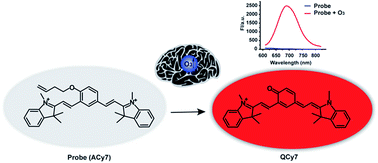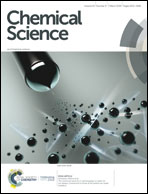In situ visualization of ozone in the brains of mice with depression phenotypes by using a new near-infrared fluorescence probe†
Abstract
Ozone (O3), one of the reactive oxygen species (ROS), is deeply involved in diseases including depression. However, the lack of appropriate in situ detection methods suitable for the complex biological context of brain impedes uncovering the exact relationship between depression and changes in the O3 level. Therefore, we developed a near-infrared (NIR) fluorescent probe (ACy7) for the direct visualization of O3 in mice brains. The specific cycloaddition reaction between O3 and the terminal double bond of the butenyl group extends the conjugation of the “pre-” heptamethine cyanine system, which emits NIR fluorescence of heptamethine cyanine. This makes the ACy7 specific, highly sensitive and able to deeply penetrate tissue. Using ACy7, we found that under glutamate stimulation, the O3 content in PC12 cells was significantly higher than that in control cells. By imaging analysis on the brains of mice, we revealed for the first time that the levels of O3 in mice with depression phenotypes were markedly higher than that in control mice. Intriguingly, experimental results unravelled that excess O3 promoted high expression of the pro-inflammatory cytokine interleukin-8 (IL-8), which ultimately induced depression phenotypes. Our work demonstrates the pivotal role of elevated O3 in depression and provides a fresh entry point for exploring oxidative stress contributing to depression.

- This article is part of the themed collection: Advances in Optical and Electrochemical Techniques for Biomedical Imaging


 Please wait while we load your content...
Please wait while we load your content...